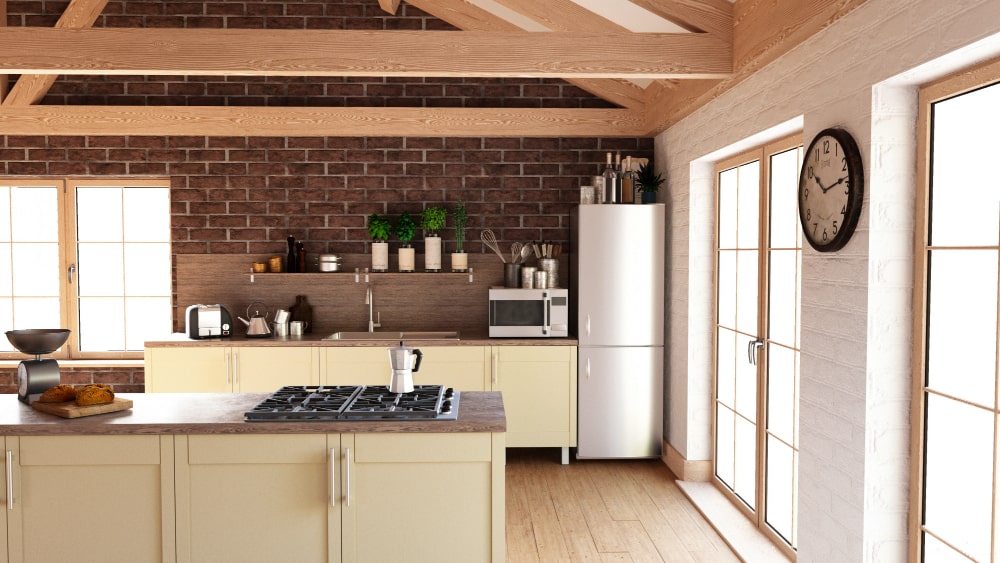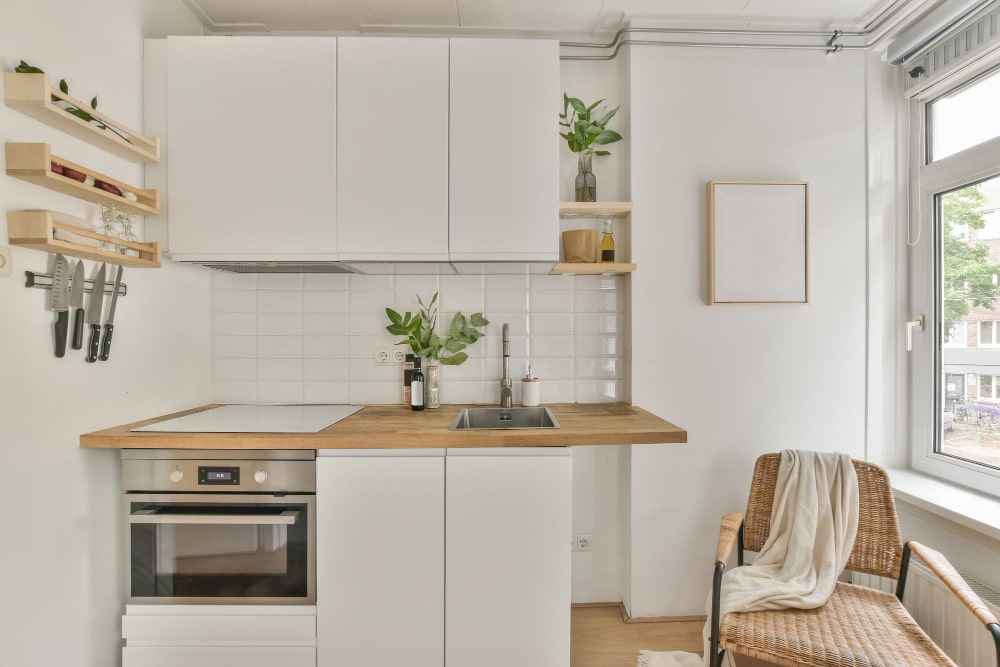
The kitchen is the heart of the home and a place where you spend a lot of time, so it’s essential to make it functional, comfortable, and stylish. To renovate your kitchen, you’re probably looking for the latest trends and ideas for the best modular kitchen design. In this article, we’ll explore the top modular kitchen design ideas and trends. To help you create the perfect kitchen for your home.
The kitchen is the centrepiece of the home, so it’s crucial to make it practical, cozy, and stylish. If you are renovating your kitchen, you might be curious about the latest trends and ideas for the best modular kitchen design.
Why Choose a Modular Kitchen Design?
A frequently asked question is why we need a modular kitchen in the first place. Modular kitchens have become increasingly popular due to their versatility and usefulness. They are designed to fit a homeowner’s particular needs and can be easily tailored to virtually any space or layout. Moreover, modular kitchens are easy to install, maintain, and upgrade. They can also be disassembled and moved to another spot if necessary. On top of that, modular kitchen designs offer many storage solutions for the best kitchen organisation.
Top Trends in Modular Kitchen Designs
| Factors | Smart Kitchens | Industrial Chic | Natural Materials | Minimalistic Kitchen | Kitchen with Bold Colours |
|---|---|---|---|---|---|
| Style Description | Emphasizes on integrating smart technology into the kitchen for convenience and efficiency. | Combines modern and rustic elements to create a unique and stylish look. | Incorporates natural materials like wood, stone, and marble for a warm and elegant ambiance. | Focuses on clean lines, uncluttered spaces, and neutral colors for a sleek and functional design. | Adds a pop of bold and vibrant colors to bring life and energy to the kitchen. |
| Key Features | Smart appliances, smartphone or voice-activated controls, energy efficiency, personalized experience. | Raw materials (concrete, metal, brick), neutral colors with brighter accents, open shelving, industrial lighting. | Wood, stone, marble, warm textures, durability, elegance. | Clean lines, uncluttered spaces, neutral colors, functional layout, natural light. | Accents or small doses of bold colors, pairing with neutrals, consideration of lighting, experimentation with shades. |
| Pros | Convenience, energy efficiency, time-saving, personalized experience. | Unique and stylish look, rugged and urban feel, easy access to items, industrial lighting. | Character and elegance, versatility, durability, timeless beauty. | Sleek and functional, timeless and sophisticated, ease of movement and use. | Vibrant and energetic, personalization, visual interest, creativity. |
| Cons | Costly, complexity, maintenance, reliability, privacy and security concerns. | Balance of modern and rustic elements, maintenance, compatibility with existing kitchen. | Maintenance, susceptibility to scratches and staining, periodic resealing, cost. | Potential for a stark look, limited storage space, may not suit all personal tastes. | Potential for overwhelming appearance, trendiness, long-term preference. |
1- Smart Kitchens

Smart kitchens are an emerging trend in kitchen design with appliances and systems controllable by your smartphone or voice-activated assistant. With smart refrigerators you can keep track of your grocery list and recommend recipes. With smart ovens you can cook your food accurately–the possibilities are endless!
Pros and Cons of having Smart Kitchen Technology
Pros: The convenience of smart kitchens is undeniable. Controlling appliances with your smartphone or voice-activated assistant can make cooking and cleaning more convenient and efficient. Furthermore, these appliances are energy efficient, allowing you to save money on the electricity bill and reducing environmental impact. Smart technology also saves time, by automating tasks like preheating the oven or brewing coffee. Additionally, they are able to learn your preferences over time, providing a more personalised experience. Even tracking contents in the fridge and pantry, as well as suggesting recipes based on what ingredients you have available.
Cons: That being said, smart kitchen appliances can be expensive compared to traditional ones. Retrofitting an older kitchen with this technology can also be costly. They may also be more difficult to use and maintain due to their complexity, plus require knowledge of technical support. Reliability could be an issue too if there’s poor connectivity or frequent power outages. Lastly, a learning curve may exist for users who have difficulty understanding how to use the features of these appliances optimally.
Ultimately it’s important to consider all the pros and cons of smart kitchens before investing in this technology.
2- Industrial Chic

Industrial chic is a on-trend design style that combines modern and rustic elements to create a unique and stylish look. This look works especially well in kitchens, where raw materials like concrete, metal, and brick are often used to create a rugged and urban feel. Neutral colours such as gray, black, and white are popular choices for this style. Along with accents of brighter colours for accessories. Open shelving allows for easy access to dishes and other kitchen items.
Industrial lighting fixtures like pendant lights or metal sconces add to the overall industrial feel. Other statement pieces such as a large metal hood or vintage industrial sink can also be added for extra charm. To get the perfect industrial chic kitchen of your dreams, balancing the modern and rustic elements is important. Using raw materials such as concrete, metal, and brick; incorporating modern elements like sleek appliances; adding warmth with wood accents; and adding character with vintage or antique pieces can bring out the best of this theme.
a- Points to keep in mind:
- Neutral Colors: Colours such as gray, black, and white are commonly used in industrial chic kitchens, creating a modern, sleek look. Accents of brighter colours can be added through accessories such as appliances, lighting, or artwork.
- Open Shelving: Open shelving allows you easy access to dishes and other kitchen items. This also helps in displaying of decorative items and adds to the overall aesthetic of the space.
- Industrial Lighting: Lighting fixtures such as pendant lights and metal sconces are often made of metal or other industrial materials, creating a sleek and modern look. They can add to the industrial feel of the space.
- Statement Pieces: Incorporating statement pieces such as a large metal hood or a vintage industrial sink can add to the overall design aesthetic of the space. These pieces serve as focal points and add to the overall charm of the space.
b- Balancing Modern and Rugged Elements
While industrial chic design may seem rough around the edges, it’s important to balance the rugged look with modern elements to create a cohesive and polished design. Here are some tips for incorporating industrial chic design into your kitchen:
- Choose a colour palette that includes neutral colours with accents of brighter colours.
- Use raw materials such as concrete, metal, and brick to create a rustic, industrial feel.
- Incorporate modern elements such as sleek appliances and statement lighting fixtures.
- Add warmth to the space with wood accents or furniture.
- Consider incorporating vintage or antique pieces to add character to the space.
Industrial chic design is a stylish and modern trend that is becoming increasingly popular in modular kitchen design. By incorporating raw materials, neutral colours, open shelving, industrial lighting, and statement pieces, you can create a unique and sophisticated look in your own kitchen. With a little creativity and a few key design elements, you can achieve the perfect industrial chic kitchen of your dreams.
3- Natural Materials

Natural materials such as wood, stone, and marble are always in style and will remain popular. When it comes to kitchen design, natural materials have always been popular choices for homeowners and designers. The warm, natural textures of wood, stone, and marble add a sense of character and elegance to any kitchen.
a- Choices in Natural Material
- Wood: Wood is a versatile material that can add warmth and texture to any modular kitchen design. From light oak to dark walnut, there are many options to choose from. In addition to being used for cabinets and flooring, wood can also be used for accents such as countertops, shelves, and even ceiling beams.
- Stone: Stone is a durable and beautiful material that has been used in kitchen design for centuries. Options such as granite, marble, and soapstone offer a wide range of colors and textures, making it easy to find the perfect fit for your kitchen. Stone can be used for countertops, backsplashes, and even flooring.
- Marble: Marble is a luxurious and elegant material that adds a timeless beauty to any kitchen design. While it can be more expensive than other options, marble countertops or a marble backsplash can add a touch of sophistication and luxury to your space.
- Combining Materials: One way to incorporate natural materials into your kitchen design is by combining them. For example, wood cabinets can be paired with a stone or marble countertop, creating a beautiful contrast of textures. A wood and stone backsplash can also add a touch of warmth and character to your kitchen.
These kitchen look really gorgeous but maintaining them can be a bit tricky as their material is natural. While they are beautiful, they can also require more maintenance than synthetic materials. For example, marble can be susceptible to scratches and staining, while wood may require periodic resealing.
a- Incorporating Natural Materials
Incorporating natural materials into your modular kitchen design is a great way to add character and elegance to your space. Here are some tips for incorporating natural materials into your kitchen:
- Choose a natural material that complements the overall style of your kitchen.
- Consider using natural materials for accents such as countertops or backsplashes.
- Combine natural materials for a beautiful contrast of textures.
- Consider the maintenance required for each natural material and choose one that fits your lifestyle.
4- Minimalistic kitchen

The trend towards minimalism and simplicity continues, with clean lines, uncluttered spaces, and neutral colors being the hallmarks of modern kitchen design. This style is perfect for those who want a sleek, streamlined look that is both functional and beautiful.
Minimalism is a modular kitchen design that has been growing in popularity over the years, and it’s no surprise why. With its clean lines, uncluttered spaces, and neutral colors, it offers a timeless and sophisticated look that is both functional and beautiful. In this article, we’ll explore the beauty of minimalism in kitchen design and how it can be incorporated into your home.
a- Benefits of having Minimalistic Modular Kitchen
- Clean Lines: One of the key features of minimalist design is clean lines. This means that cabinets, countertops, and other elements should have simple and straight edges, with no ornate details or embellishments. This creates a streamlined and uncluttered look that is both modern and elegant.
- Neutral Colors: Neutral colors are another hallmark of minimalism. Colors such as white, beige, and gray create a calm and serene atmosphere, and allow the focus to be on the design and function of the kitchen. A neutral color palette also provides a great backdrop for adding pops of color through accessories and decor.
- Functional Layout: Minimalism is not just about the look of the kitchen, but also about its functionality. A minimalist kitchen should have a well-designed layout that maximizes storage space and makes it easy to move around and work in. This means that appliances and cabinets should be strategically placed for ease of use and convenience.
- Natural Light: Natural light is an important element of minimalist design. It not only creates a sense of openness and spaciousness, but it also enhances the beauty of the space. Large windows, skylights, and glass doors are great ways to bring natural light into your kitchen.
- Incorporating Texture: While minimalism is all about simplicity, adding texture is a great way to add depth and interest to the design. Textured finishes such as matte or brushed metals, concrete, or natural wood can add warmth and character to your minimalist kitchen.
- Incorporating minimalism into your kitchen design is a great way to create a sleek and functional space that is both beautiful and timeless. Minimalism is a design style that offers a timeless and sophisticated look that is both functional and beautiful. By incorporating clean lines, neutral colours, a functional layout, natural light, and texture into your kitchen design, you can create a space that is both modern and elegant, and that will stand the test of time.
5- Bold Colours In Modular Kitchen Design

The kitchen is the heart of the home, and it should reflect your personal style and taste. While neutrals have been the go-to colour palette for many years, bold and vibrant colours are now making a comeback in kitchen design. From rich jewel tones to bright primary colours, adding a pop of colour can bring life and energy to any kitchen. In this article, we’ll explore the benefits of incorporating bold colours into your kitchen design and offer tips for doing it right.
a- Tips for Using Bold Colours in Modular Kitchen Design–
- Use them in moderation: While bold colours can add excitement to your kitchen, too much can be overwhelming. Use bold colours as accents or in small doses, like on a kitchen island or backsplash.
- Pair bold colours with neutrals: To keep your kitchen design balanced, pair bold colours with neutral colours like white or gray. This will prevent your space from feeling too busy or chaotic.
- Consider the lighting: Lighting can have a big impact on the way colours appear in your kitchen. Consider the natural and artificial lighting in your space when choosing your colour palette.
- Experiment with different shades: Don’t be afraid to experiment with different shades of the same colour. For example, if you love blue, try incorporating different shades of blue into your kitchen design to create a cohesive and visually interesting space.
- Think long-term: While bold colours may be trendy now, they may not be in a few years. When incorporating bold colours into your kitchen design, consider how they will hold up over time and whether you’ll still love them in a few years.
If you feel inspired after reading this article and have decided to jazz-up your kitchen, here are some additional tips you should go through before starting on this adventure:
b- Tips for the Perfect Modular Kitchen Design
- Start with a Plan: Before you start designing your modular kitchen, it’s essential to have a plan in place. Think about your cooking and eating habits, your storage needs, and your budget, and use this information to create a detailed plan that includes the layout, appliances, and finishes you want.
- Consider the Workflow: When designing your kitchen layout, think about the workflow and how you move around the space. Make sure that your appliances, countertops, and storage solutions are positioned for maximum efficiency and ease of use.
- Choose Quality Materials: A modular kitchen is an investment in your home, so it’s essential to choose quality materials that will stand the test of time. Look for durable materials such as solid wood, stainless steel, and natural stone, and choose finishes that are easy to clean and maintain.
- Optimize Storage: One of the advantages of modular kitchen designs is the wide range of storage solutions available. Take advantage of this by choosing cabinets, drawers, and shelves that maximize your storage space and keep your kitchen organized and clutter-free.
- Lighting is Key: Good lighting is essential in any kitchen, and modular kitchens are no exception. Choose lighting solutions that are both functional and beautiful, such as pendant lights, under-cabinet lighting, and recessed lighting.

